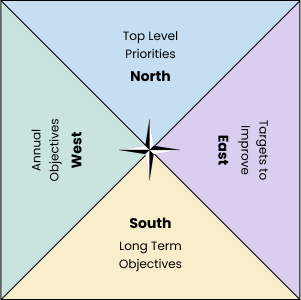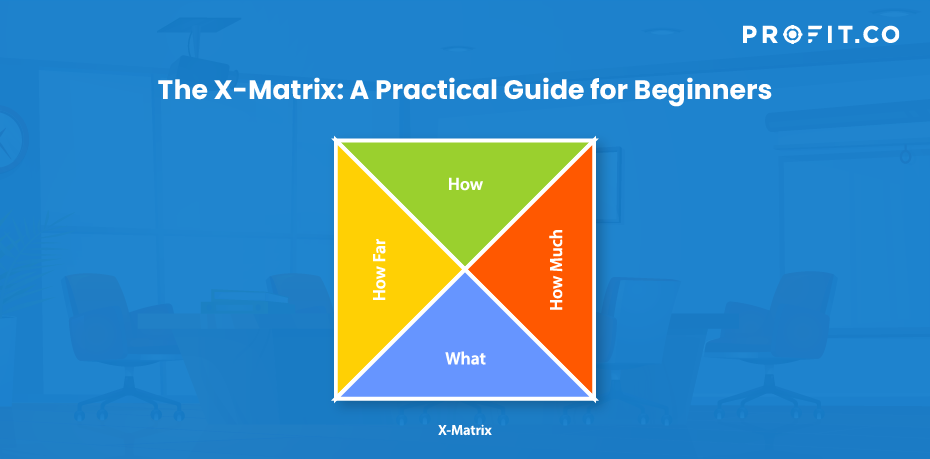Key Takeaways
- The X-Matrix is the one-page visual that makes Hoshin Kanri actionable.
- It connects business drivers, annual objectives, initiatives, and ownership in a single framework.
- Cascading the X-Matrix aligns company and department goals.
- Relationship mapping shows how strongly initiatives support objectives.
- Both vertical and horizontal formats have their uses. Choose based on readability needs.
What Does the X-Matrix Solve?
If you’ve ever sat in a strategy review meeting with ten different slide decks, each using a different structure for goals, you’ll know the frustration and how good work gets lost in translation.
The X-Matrix was designed to solve that.
In Hoshin Kanri, it’s the single visual that connects long-term business drivers to the annual objectives, the key initiatives, and the people responsible for delivering them. Everything fits in one place. Not required to flip through multiple documents to figure out what connects to what.
For beginners, the challenge isn’t just learning the layout, it’s learning to read it, use it, and adapt it for your organization.
We cannot solve our problems with the same thinking we used when we created them
The Four Quadrants of the X-Matrix
At its core, the X-Matrix is made up of four interconnected sections arranged in a cross or “X” pattern.X1 – Business Drivers
These are the long-term strategic imperatives that define where the organization is heading over the next 3–5 years. Examples might include improving quality, reducing costs, increasing market share, or enhancing safety. In the X-Matrix, they form the “south” position, the anchor for everything else.X2 – Annual Objectives
Annual objectives sit on the “east” side of the matrix. These are specific, measurable targets for the current year that directly advance the business drivers.X3 – Initiatives or Priorities
Initiatives occupy the “north” side. These are the high-level projects or programs that will deliver the annual objectives. They’re not daily tasks, but substantial, outcome-driven efforts.X4 – Owners
On the “west” side are the people accountable for each initiative. The X-Matrix makes ownership explicit, showing both the primary owner (responsible for delivery) and supporters (contributing to success). Here is a quick summary:| Quadrant Position | Content (Typical) |
|---|---|
| North (Top) | Improvement Projects / Initiatives |
| East (Right) | Metrics (KPIs), sometimes Owners |
| South (Bottom) | Long-term / Breakthrough Objectives |
| West (Left) | Annual Objectives |

How to Read the X-Matrix
The beauty of the X-Matrix is in its visual relationships. Lines or dots mark where one element supports another.- From X1 to X2: Which annual objectives advance each business driver.
- From X2 to X3: Which initiatives deliver each annual objective.
- From X3 to X4: Who is responsible for each initiative.

What is Cascading in the X-Matrix?
Once you can read these relationships at a single level, the real power comes from connecting multiple X-Matrices across your organization. One X-Matrix is powerful. Multiple, connected X-Matrices create true organizational alignment. Cascading means taking the company-level X-Matrix and using it as the starting point for the next level down, usually departments or business units. Here’s how it works:- Rotate the Matrix The company’s annual objectives (X2) become the “north” or left-hand priorities in the department’s matrix.
- Department Sets Initiatives The department defines its own initiatives (X3) that directly support those objectives.
- Assign Owners Department initiatives get their own primary owners and supporters, ensuring accountability at every level. Most organizations stop at two levels: company and department. This keeps the process manageable while still ensuring alignment.
- Strong relationship : The initiative is a primary enabler of the objective.
- Medium relationship : The initiative has a significant but secondary effect.
- Weak relationship : The initiative provides only indirect support.
- It highlights under-supported objectives.
- It shows where initiatives might be misaligned.
- It helps focus conversations about priorities.
- Impact- How strongly it contributes to a business driver.
- Accountability -Whether the person is the owner or a supporter.
- Complexity – The effort, time, and resources required.
- Compact and fits easily on one page
- Matches traditional Hoshin Kanri training materials
- Harder to read in meetings, requires physical rotation or awkward screen viewing
- Less intuitive for people new to the format
- Easier to read on screens or in group settings
- Facilitates live discussion without rotating the view
- Can require more space, doesn’t always fit neatly into a single printed page
- Slightly departs from the traditional visual, which may confuse those trained in the vertical style
- Over-cascading Trying to push the matrix down to too many levels at once.
- Neglecting updates Letting the plan go static undermines its value.
- Unbalanced relationships Too many weak links indicate misalignment.
- Too many drivers More than 3–5 can dilute focus.
- Limit the number of business drivers
- Post it where teams can see it or keep it in a shared workspace.
- Review regularly with monthly or quarterly check-ins to keep it relevant.
- Engage the ownersto get more commitment.
- Use relationship mapping actively by discussing what they mean.
Solve your specific planning challenges and get your team moving in the same direction
What is Relationship Mapping?
Not all initiatives contribute equally to an objective. The X-Matrix captures this by marking the strength of each relationship. Relationship mapping is how the X-Matrix captures this reality by marking the strength of each connection between initiatives and objectives.What are Strong, Medium, Weak in Relationship Mapping?
Weighting: Bringing Objectivity to Prioritization
When everything feels important, weighting helps decide where to focus.Execution priority is required for team clarity. In many Hoshin Kanri implementations, each initiative is scored on three factors:How to Choose Between Vertical & Horizontal Formats
The original X-Matrix is vertical, with the quadrants arranged so that reading certain connections requires tilting your head or rotating the document. While this compact format works for printouts, it can cause what some call the “neck twist problem” during live reviews.
| Format | Pros | Cons |
|---|---|---|
| Vertical | ||
| Horizontal |
If your team reviews the X-Matrix frequently in meetings, the horizontal format often wins for accessibility. If your priority is compactness and traditional form, stick with vertical.
What are the Common Pitfalls for Beginners Using the X-Matrix?
What are the Best Practices for a First Implementation?
Conclusion: A Tool You’ll Actually Use
The X-Matrix is more than a diagram, it’s a way to keep an organization pointed in the same direction, from long-term strategy to daily action. By showing the connections between drivers, objectives, initiatives, and owners on one page, it eliminates guesswork and keeps priorities visible.
Whether you stick with the vertical format or adapt to a horizontal view, the real value comes from using the X-Matrix as a living, regularly reviewed map not just a planning artifact.
For beginners, the key is to start simple, cascade thoughtfully, and revisit often. Done right, the X-Matrix turns strategy from a document into an everyday guide for execution.




